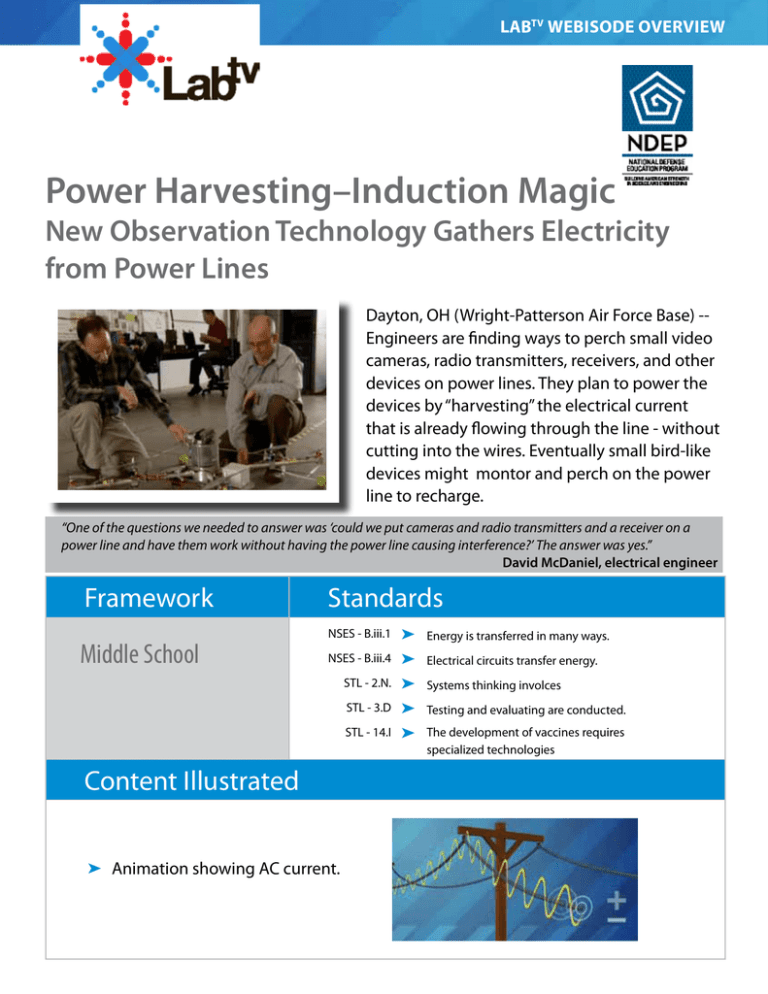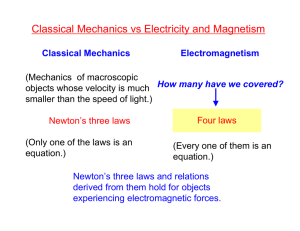Power Harvesting–Induction Magic
advertisement

LABTV WEBISODE OVERVIEW Power Harvesting–Induction Magic New Observation Technology Gathers Electricity from Power Lines Dayton, OH (Wright-Patterson Air Force Base) -Engineers are finding ways to perch small video cameras, radio transmitters, receivers, and other devices on power lines. They plan to power the devices by “harvesting” the electrical current that is already flowing through the line - without cutting into the wires. Eventually small bird-like devices might montor and perch on the power line to recharge. “One of the questions we needed to answer was ‘could we put cameras and radio transmitters and a receiver on a power line and have them work without having the power line causing interference?’ The answer was yes.” David McDaniel, electrical engineer Framework Middle School Standards NSES - B.iii.1 ➤ Energy is transferred in many ways. NSES - B.iii.4 ➤ Electrical circuits transfer energy. STL - 2.N. ➤ Systems thinking involces STL - 3.D ➤ Testing and evaluating are conducted. STL - 14.I ➤ The development of vaccines requires specialized technologies Content Illustrated ➤ Animation showing AC current. Content Physical Science ➤➤ An electric current flowing through a wire emits a magnetic field. ➤➤ With alternating current (AC) electricity, the direction of the current reverses 60 times per second. The charge at the ends of the wires alternates between positive and negative, which creates a magnetic field around the wires. ➤➤ With direct current (DC) electricity, all the electrons flow in one direction. ➤➤ Technology ➤➤ Power lines use A/C electricity. Batteries use D/C electricity. ➤➤ Power harvesting, through electromagnetic induction, converts magnetic energy into an electrical current. ➤➤ Electromagnetic induction powers generators, motors, and electric toothbrushes. ➤➤ Engineering ➤➤ A question the featured engineers had to answer was whether or not video and radio equipment could be installed on power lines without picking up interference from the line. ➤➤ To harvest power from power lines, the engineers used electro magnetic induction. Knowing that an electric current flowing through a power line emits a magnetic field, they developed a way to wrap a circuit around the power line to capture that magnetic energy and turn it back into electricity. ➤➤ A silicon-steel split core is placed around the power line, without actually touching it, in order to concentrate the line’s magnetic fields. A copper wire wrapped around the core itself, is then able to generate the electric current that can be used by other devices. Thus, a power harvesting circuit is made without actually touching the power line. ➤➤ Sensor devices, such as cameras, which draw power from the harvester, are designed to blend in and be hard to spot 50 feet up on power lines. ➤➤ Engineers are designing small flying craft to deliver the power harvesters to power lines. They are also working on single devices that could be complete systems - able to fly, perch, charge themselves, and take and transmit pictures. Guiding Questions To think about as you watch: ➤ What are the steps the engineers went through, from idea to full-scale test? What was significant about each small step toward making a power-harvesting sensor/transmitter? Suggested Activities ➤ Generate an alternating current using a hand held dynamo and measure the voltage created with a voltmeter. s Keywords alternating current (AC), batteries, direct current (DC), electro-magnetic field, inductive coupling, magnetic field, payload, sensor ➤ Power Harvesting can be found online at www.ndep.us/Power-Harvesting-Induction-Magic. Visit www.ndep.us/ LabTV for a list of process skills modeled in webisodes.



